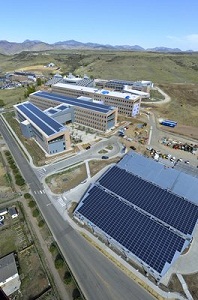With the Cloud growing, how will renewable energy affect data centers?
 A new partnership between computer chip maker AMD (NYSE: AMD), HP (NYSE: HPQ), Clarkson University and the New York State Energy Research and Development Authority (NYSERDA) is studying how the integration of renewable energy sources, like wind and solar, and co-located renewable energy, will affect ‘the cloud’ and data centers, which are now popping up throughout the world. Among other things, the study will look at how renewable energy will affect the large-scale transfer of that data.
A new partnership between computer chip maker AMD (NYSE: AMD), HP (NYSE: HPQ), Clarkson University and the New York State Energy Research and Development Authority (NYSERDA) is studying how the integration of renewable energy sources, like wind and solar, and co-located renewable energy, will affect ‘the cloud’ and data centers, which are now popping up throughout the world. Among other things, the study will look at how renewable energy will affect the large-scale transfer of that data.
“The distributed-computing model of the cloud parallels the distributed power-generation model of solar and wind energy.” Alan Lee, corporate vice president of Research and Advanced Development at AMD, said in a press release. “Directing power to data centers from these emerging renewable energy resources without relying on a large-scale, traditional electrical grid is a key challenge.”
Another challenge is how data centers can co-locate renewable energy to help reduce the reliance on the grid even as the centers are moving significant amounts of data.
“A simple example would be what happens if the wind dies down in one area where a lot of work is happening in that area’s connected data center?” said Steve Kester, director of Government Relations and Regulatory Affairs at AMD. “The work can’t wait until the wind picks up, so we’ll try to understand how we can reliably shift the work being done in one data center to another data center that might be several states away.”
The study, being conducted by Clarkson, is being funded in part by NYSERDA and private funding.
“The first phase of the research is a feasibility study that the team at Clarkson University will begin in the next few months,” Kester said. “This phase does include work with hardware and software; although the actual demonstration network would begin in a separate, second phase.”
The scope of the study has not yet been determined.
“The study will look at several scenarios and is designed to help us better understand a number of complex problems. One is how to we eliminate as much of the traditional ‘grid’ infrastructure as possible between renewable energy sources and the data center, reducing transmission and infrastructure costs,” Kester said. “Another question is then how can we shift the computing work being done in one data center reliably to another renewable-powered data center as needed, because fluctuations are to be expected with wind and solar energy.”
The project will also look at how onsite wind and solar energy can be optimized by consuming the power generated on site, according to Kester, and look at how to optimize the compute shift mechanism for data centers’ power consumption.
“This model has the potential to greatly reduce, and possibly eliminate at some point, reliance on the grid,” he said.
Image courtesy of NREL.



